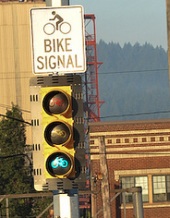
agenda in Salem today.
(Photo © J. Maus)
The Oregon State Legislature is getting down to business this week and there’s a bike-related bill that’s already getting some action. Senate Bill 130 (text) would add green, yellow and red bicycle signals to Oregon’s list of officially accepted traffic control devices. The Oregon Department of Transportation (ODOT) is behind the bill and it’s being supported by the City of Portland, the Bicycle Transportation Alliance, and others.
Peter Koonce, Signals and Street Lighting Division Manager for the City of Portland Bureau of Transportation (PBOT) is in Salem today to testify in support of the bill at a work session of the Senate Committee on Business, Transportation and Economic Development.
I caught up with Koonce this morning to find out more about what’s in the bill and what’s at stake for bicycling.
“We have used bike signals to remove confusion and improve safety of our streets… They give road users better information than what they have today.”
— Peter Koonce, PBOT
Koonce wants the bill to pass because it would give him and other signal engineers throughout Oregon more leeway in using bicycle signals. Currently, bicycle signals are not included in the Manual on Uniform Traffic Control Devices (MUTCD) — the federal manual that dictates what type of traffic controls can legally be used on our roadways. The feds are currently considering the addition of bicycle traffic signals to the MUTCD, but that process is still underway.
In the meantime, Koonce says, traffic signal law is full of grey areas. “If you look at the law, it’s questionable whether or not violations of bicycle signals are enforceable… Because the bike symbol, per se, is not recognized in statute.” The legal grey area isn’t the only problem. Engineers throughout the state are less-inclined to install bike signals without the endorsement (and legal protection that comes with it) of the MUTCD.
Lack of recognition in Oregon and federal law hasn’t stopped PBOT from using bike signals. PBOT installed the city’s first bike signal at N. Interstate and Oregon (just above the Eastbank Esplanade) way back in 2004. Bike signals are also in operation at E Burnside and 41st and more recently at Broadway and N. Williams.
Portland isn’t the only city that wants bike signals to get an official endorsement. Koonce says engineers in the City of Ashland (in southern Oregon) have also proposed one, but without an Oregon law in place, they’d have to go through the lengthy process of requesting an “experiment” to use them through the Federal Highway Administration (FHWA).
If SB 130 passes, state law would have precedence over the MUTCD and traffic engineers throughout Oregon would have the green light to install them.
In Salem today, Koonce intends to share with legislators that use of bicycle signals would improve Oregon’s traffic operations. “We have used bike signals to remove confusion and improve safety of our streets… They give road users better information than what they have today.” Koonce adds that the new law would simply articulate what they’re already doing. “The bill basically codifies a technique we have used for years.”
SB 130 was introduced by ODOT, a fact Koonce says, makes its chances of passing much more likely. “The fact that ODOT is taking a leadership role on this issue helps us.” The Bicycle Transportation Alliance (BTA) is also expected to testify in support of the bill.
Stay tuned for more coverage of this and other legislative efforts. Read past coverage of the 2011 Legislative Session here.

